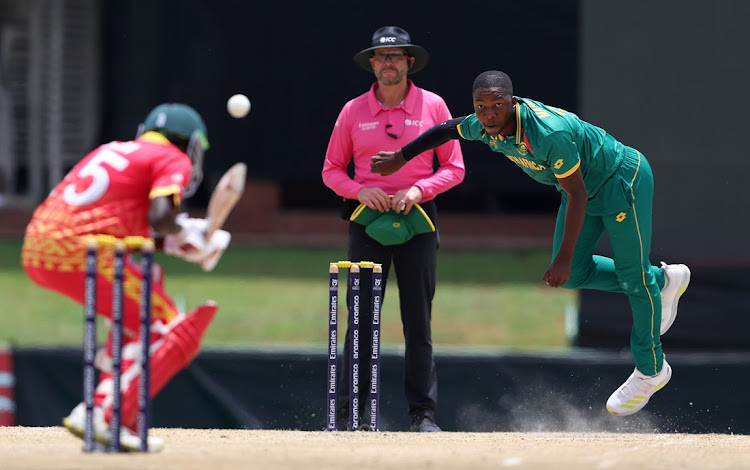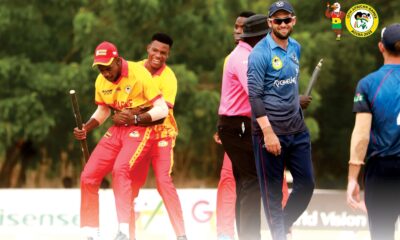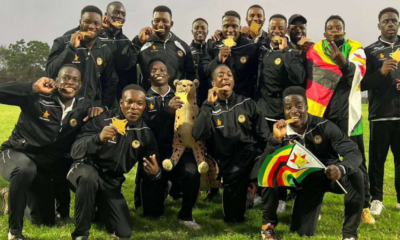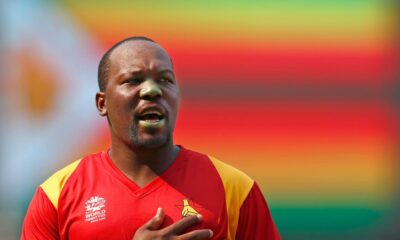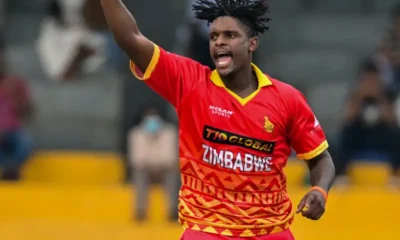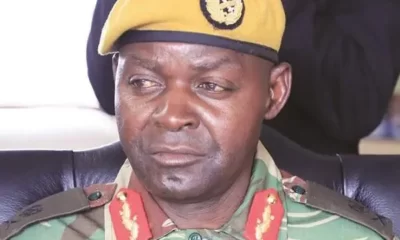KWENA Maphaka, a 17-year-old certain future star of world cricket, on Wednesday ripped apart Zimbabwe’s batting with a devastating spell of fast bowling at the on-going Under-19 World Cup in South Africa.
ENOCK MUCHINJO
It was a virtuoso display of natural athleticism that sure has left Proteas fans salivating at the prospect of watching this kid – and I don’t think that will take a very long time – bowling in tandem with the South Africa champion bowler Kagiso Rabada.
The left-armer from Johannesburg claimed 5-34 in South Africa’s nine wicket destruction of the neighbours in Potchefstroom, his second five-wicket haul of the Youth World Cup.
And then when you draw high praise from none other than the great Ian Bishop, who in his pomp was one of most feared quicks on the planet, you know you’ve got that something special.
“Kwena is a very polished young bowler, and young man too,” commented the West Indian legend, now a broadcaster. “He understands mentally when he talks through his bowling. He knows what he is doing, his ability to attack stumps, meaning he has space through the air. Which means if a pitch has something in it, it makes him much more challenging to face. He can get the bounce up, he can go yorker. Then at times he can swing the ball….And he is 17, he can always play another Under-19 World Cup. That is a terrorising sign!”
These are hardly words to ignore, coming from one of the greatest of all time. But for me, Maphaka’s five-star performance on Wednesday sticks out, of course, because it was against Zimbabwe. I’m sure, watching the Kwena Show of Wednesday as a Zimbabwe fan, it’s not just me who got hit with a wave of nostalgia to think how this country used to unleash its own fast men of note at this Youth World Cup.
The sudden rush of memories took me back to Zimbabwe’s first Under-19 World Cup, in South Africa in 1998, when Mluleki Nkala got everybody excited with his raw pace to finish as the tournament’s joint-highest wicket-taker alongside Ramnaresh Sarwan of West Indies.
For Nkala to bowl as he did in that Under-19 World Cup, while so young, revealed a great deal of his prodigious talents back then. With Greg Lamb, they were the youngest players in Zimbabwe’s squad, both aged just 16.
Kwena Maphaka reminds me of our own Mluleki not only because they both bowled exceptionally well in the Youth World Cup at young ages. Mluleki did return for a second Under-19 World Cup, now as Zimbabwe’s captain in the 2000 edition in Sri Lanka. Kwena could well also return in two years’ time for another World Cup, in Zimbabwe and Namibia in 2026, but most likely be mixing with the big guys already at that time. This youngster has already played first-class cricket for South Africa ‘A’ on tour in Sri Lanka last June. He may be be knocking hard on the Proteas door by the time his age-mates come up to these parts in 2026.
As for the other similarities, both have the same kind of physical features at that age, the same ability to swing the ball at that level. Both hugely benefitted from the privilege of good private schooling and received quality coaching in the formative stages.
However the most important comparison to note is that both Nkala and Maphaka, in their different eras, are products of a sound cricketing system in their two countries at different times. Their natural talents were identified and nurtured very early, which means they were groomed as national assets early on – the future of the game in their countries.
In the case of Nkala, very early on he had been deliberately raised in Zimbabwean cricket – when change and transformation increasingly became inevitable – to sooner or later become the country’s first black captain.
That, we all know now, didn’t happen as of course Tatenda Taibu would emerge from behind the queue to take on the mantle. This is not the only potential of Nkala that never materialised. His fellow highest wicket-taker at the Under-19 World Cup of 25 years ago, Sarwan, went on to establish himself as a batsman in the senior West Indies side – averaging 40 in both Tests and ODIs – all-round attributes that Nkala was also tipped to take to the international stage.
But I deviate, because I’m speaking specifically here about exciting Zimbabwean fast bowling resources of a bygone era and true to the supply chain those days, another quickie from this country became the Under-19 World Cup joint-highest wicket-taker four years after Nkala’s feat.
It was Waddington Mwayenga, who I mentioned in passing on this blog last week. Mwayenga, like Nkala before, had 16 scalps, tied with Xavier Doherty of Australia in New Zealand in the 2002 tournament.
I was lucky, like many others who will testify to it, to watch both in their raw youth, bowling like the well-coached and naturally talented pacers they were – passion, speed, putting the ball in the right areas consistently, beating the pad.
It’s no coincidence that they kept coming out of Zimbabwe, demonstrating a range of bowling skills to the world at the Youth World Cup. We soon had Tinashe Panyangara tearing through Australia’s batting line-up in that famous win at the 2004 edition in Bangladesh – the rangy pacer’s heroic 6-31 being a major factor in one of the most memorable Under-19 World Cups for Zimbabwe.
In a few later tournaments Zimbabwe has sent some pretty decent pace bowlers to the Youth World Cup, and were capped internationally with varying success: Kyle Jarvis, Tendai Chatara, Ian Nicolson, Taurai Muzarabani.
But there hasn’t been anything really special to talk about post-2010, in comparison to the exploits of the past. It makes me worried.
I had tried to avoid, on the whole, to put this down to the collapse of cricket structures in this country across the board. But you can’t avoid it, because this clearly is the fundamental reason for the results we consistently get now, from the seniors to the juniors.
Things have been falling apart for a long time. The wreckage from the plunge is now weighing heavily on the foundation below, down to the base of Zimbabwean cricket when the nation used to unearth its gems.
I refuse to accept that there is no longer talent in the country, because Newman Nyamhuri wouldn’t be bowling as good as he has been in this current Under-19 World Cup in South Africa.
Reestablish the structures and guaranteed there will be even more exciting talents coming through the future Under-19 World Cups, like it used to be.
